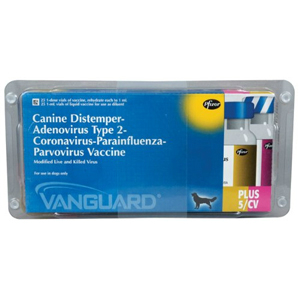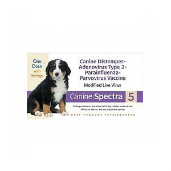"Parvo" is one of the most severe and deadly diseases that can affect young dogs. It is highly contagious and spreads quickly through groups of unprotected individuals. Most disturbing is the fact that the virus that causes the disease, canine parvovirus type 2 (CPV-2), can survive for an extremely long time in the environment and is resistant to many commonly used cleaning solutions and disinfectants. Therefore, even settings that appear to be impeccably clean can harbor and spread this deadly virus.
"Currently available vaccines continue to provide excellent protection against canine parvovirus as long as they are given on an appropriate schedule."
When a dog has parvo, it releases large numbers of the virus in its feces, saliva, and vomit. A susceptible dog will pick up the disease when the virus gains access to the body through the mouth. This often occurs when a dog mouths something in the environment or grooms themselves after picking up the virus on its feet, coat, or skin.
Symptoms of Canine Parvovirus

Clinical signs of parvovirus generally begin within a few days to a week of a dog becoming infected. The severity of the symptoms depends on the number of virus particles the dog came in contact with and the speed and strength with which its immune system reacts. Dogs that have partial immunity to the virus and/or were exposed to relatively few virus particles may only become somewhat lethargic, go off their food, and experience mild vomiting and diarrhea for a few days before recovering fully.
On the other hand, more severe parvovirus infections are often fatal without prompt and aggressive treatment. Dogs with little or no immunity to the disease or those that come in contact with heavily contaminated areas can develop:
- complete loss of appetite
- repeated bouts of vomiting
- diarrhea that tends to contains blood
- severe dehydration
- extreme depression and lethargy
- high fever
The virus attacks rapidly dividing cells in the body. The gastrointestinal system is its primary target, but parvo can also have a direct adverse effect on the cells of the immune system. This development not only lessens the dog’s ability to fight off parvovirus, but also puts it at risk for secondary bacterial infections, often originating from within the compromised gastrointestinal tract. These infections can result in pneumonia and other potentially life-threatening complications. In very young puppies, the virus can attack cells within the heart. These dogs may either die suddenly or go into congestive heart failure and experience difficulty breathing, fluid build-up in the body, and extreme weakness.
Diagnosing Parvovirus
Parvo is not the only disease that can cause vomiting, diarrhea, and the other symptoms mentioned above. Intestinal parasites, bacterial infections, other viruses, ingestion of foreign material, pancreatitis, and more can all be mistaken for parvovirus. Parvo becomes more likely when the affected dog is young and has an incomplete vaccination history. The diagnosis can be confirmed with a bench-top test that is performed on a small sample of feces. Results are usually available within 10-15 minutes. As with any type of laboratory test, false positive and false negative results are possible. Recently vaccinated dogs may appear positive on the test when they are truly not infected with the virus, and some individuals may test negative very early in the course of the disease.
To determine the severity of a dog’s infection, rule out other diseases, and plan appropriate treatment, veterinarians often also run a complete blood cell count, a blood chemistry panel, fecal parasite testing, and chest and/or abdominal x-rays.
Treatment for Parvovirus
Treatment for canine parvovirus is essentially symptomatic and supportive. Dehydration is addressed and blood pressure maintained with fluid therapy. Extremely mild cases of parvo may respond to oral or subcutaneous fluid therapy, but the majority of dogs require hospitalization for intravenous fluids. Electrolyte and other blood chemistry abnormalities (e.g., low blood sugar levels) can be addressed by adding appropriate supplements to the fluids.
Anti-nausea and vomiting medications are essential to the treatment of parvovirus. Many drugs may be used successfully to treat vomiting in dogs. A common first-line choice is maropitant (Cerenia). In severe cases, several anti-vomiting drugs may be used in combination. All dogs with parvovirus should also receive broad-spectrum antibiotics to treat and/or prevent secondary bacterial infections. Initially, many dogs require injectable forms of these medications, but once their vomiting is under control, they can be switched to oral formulations. Veterinarians will sometimes also prescribe sucralfate and/or antacids to promote healing of the gastrointestinal tract.

Dogs with severe parvovirus infections may need blood or plasma transfusions and other advanced therapies. The use of antiviral medications (e.g., Tamiflu) in dogs with parvo is controversial but can be considered on a case by case basis.
Research has shown that when dogs with parvovirus are not treated, a death rate of around 90% can be expected. Conversely, when dogs are hospitalized in a timely manner and treated aggressively, survival rates can reach 80-95%.
Preventing Parvovirus in Dogs
Vaccination is very effective at preventing parvovirus in dogs. Puppies should be isolated in environments that are known to be free from parvovirus contamination until they
are six to eight weeks of age. At this point, they can begin their vaccination series, which includes a parvovirus vaccine given every three to four weeks until they are sixteen weeks of age. The last parvo vaccine must be given when they are between fourteen and sixteen weeks of age to ensure that any immunity they received from their mother has waned and can no longer inactivate the vaccine.
Depending on when a puppy starts this series, it must receive a total of either three or four vaccines to be considered fully protected from parvovirus. An additional booster should be given at the dog’s one year check-up. Adult animals with an unknown vaccination history can receive a single, initial parvo vaccine. Previously vaccinated adult dogs can either receive parvo boosters every three years or have their immunity checked through a vaccine titer.
Several different strains of the canine parvovirus have arisen over the years, but currently available vaccines continue to provide excellent protection against the disease as long as they are given on an appropriate schedule.
Sources
Goddard A, Leisewitz AL. Canine parvovirus. Vet Clin North Am Small Anim Pract. 2010 Nov;40(6):1041-53.
Prittie J. Canine Parvoviral Enteritis: A Review of Diagnosis, Management, and Prevention. J Vet Emerg Crit Care. 2004 Vol 14 (3): 167-76.
Petrollini Rogers E, Otto C. Canine Parvovirus. International Veterinary Emergency and Critical Care Symposium 2009.
The above is provided for information purposes only and should not be used for the diagnosis or treatment of any condition.
This information does not cover all possible variables, conditions, reactions, or risks relating to any topic, medication, or product and should not
be considered complete. Certain products or medications may have risks and you should always consult your local veterinarian concerning the treatment of
your pet. Any trademarks are the property of their respective owners.